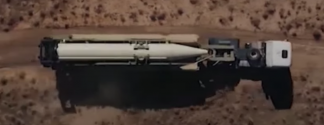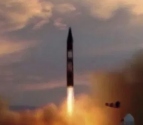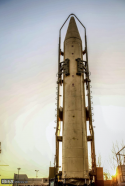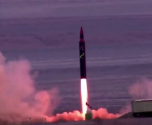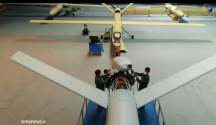You are using an out of date browser. It may not display this or other websites correctly.
You should upgrade or use an alternative browser.
You should upgrade or use an alternative browser.
Iranian Military News, Reports, Data, etc.
- Thread starter ShahryarHedayat
- Start date
IRGC AS-F underground ballistic missile magazine launcher facility for MRBMs
IRGC-ASF January 2021 drills:
From 1:35-1:55 is beautiful.
From 1:35-1:55 is beautiful.
Last edited:
Compilation of footage of Iranian ballistic missiles (Shahab-3, Ghadr, Qiam, Emad, Khorramshahr, Fateh, Zolfaqar, Dezful, Sejil):
(Video does not include newer, even more advanced models such as Haj Qasem or Raad-500.)
(Video does not include newer, even more advanced models such as Haj Qasem or Raad-500.)
Last edited:
Haj Qasem hypersonic Q-MRBM (single-stage, solid-fuel, 1400km range, max speed 12 mach) - unveiled in 2020
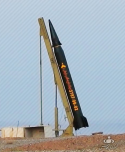
The Haj Qasem missile is a single-stage, solid-fuel quasi-ballistic missile with 1400km range, 650kg warhead and composite motor casing. The missile flies in a depressed (quasi-ballistic) trajectory and does not leave the atmosphere, rendering exo-atmospheric ABM systems redundant (e.g. Israeli Arrow-3). The hypersonic missile reaches a max speed of mach 12, but the MaRV slows to mach 5 on impact; meaning it possesses huge energy reserves for pre-impact aerodynamic avoidance manoeuvres to confuse and kinematically defeat ABM interceptors (e.g. Patriot PAC-2/3).
Haj Qasem is also very mobile: 7000kg mass, 0.9m diameter and 11m length. The missile is broadly similar in dimensions and power to the US Pershing II missile (but single-stage) and role to the Russian Iskander missile (but much greater max speed as Iskander max speed is mach 6 vs mach 12 for Haj Qasem, and thus greater kinematic reserves for anti-ABM manoeuvres).
Source:
(Full credit to Patarames)
Limitations/potential upgrades:
Probably the overall most advanced known ballistic missile in Iran's possession (along with Raad-500). It was designed to be affordable and easy to mass produce, hence some of the limitations above that will inevitably be improved for future upgrades to Haj Qasem, to produce: a single-stage, 2000km range HGV in the Chinese DF-17 class.

The Haj Qasem missile is a single-stage, solid-fuel quasi-ballistic missile with 1400km range, 650kg warhead and composite motor casing. The missile flies in a depressed (quasi-ballistic) trajectory and does not leave the atmosphere, rendering exo-atmospheric ABM systems redundant (e.g. Israeli Arrow-3). The hypersonic missile reaches a max speed of mach 12, but the MaRV slows to mach 5 on impact; meaning it possesses huge energy reserves for pre-impact aerodynamic avoidance manoeuvres to confuse and kinematically defeat ABM interceptors (e.g. Patriot PAC-2/3).
Haj Qasem is also very mobile: 7000kg mass, 0.9m diameter and 11m length. The missile is broadly similar in dimensions and power to the US Pershing II missile (but single-stage) and role to the Russian Iskander missile (but much greater max speed as Iskander max speed is mach 6 vs mach 12 for Haj Qasem, and thus greater kinematic reserves for anti-ABM manoeuvres).
The more energy the interceptor is forced to dissipate by counter/reaction maneuvering, the smaller its engagement envelope becomes. The area it is able to protect becomes smaller, to a point, at which it will never reach the attacking missiles rendezvous position at all.
In the case of the mach 12 Haj Qasem missile, energy must be dissipated in order to slow it down to below mach 6 at impact. Hence the kinetic energy equivalent of 6 mach numbers is available to its MaRV for late cruise phase and terminal phase maneuvering. The dissipated energy will heat up the MaRV and cause the desired positional changes.
Relatively low g maneuvers that change the heading angle by few degrees will, at those high speeds, create large difference in distance of missile to interceptor. The more energy reserve/speed is available, the more such heading angle change cycles can be performed, to which the interceptor must react, since it doesn't know what the intended target is.
As the maneuvers become more intense the closer the missile comes to its target, it suddenly goes vertical with highest intensity maneuvering to hit the intended object from above. This vertical dive maneuver increases the unpredictability and makes interception more difficult.
The Iskander can only perform late and relatively few maneuvering cycles during its vertical dive, primary intended to defeat PAC-3 and David Sling type terminal ABM interceptors. Haj Qasem starts earlier, with more cycles, of more severe vector variations.
This improves its performance against high kinematic capability, area-defense interceptors like the Arrow-2 and further reduces engagement envelopes to points where the ABM system itself can be attacked.
Source:
(Full credit to Patarames)
Limitations/potential upgrades:
- Composite motor casing (unlike more advanced Raad-500 carbon fiber filament motor casing - probably chosen to reduce design complexity and cost of production).
- MaRV based on Zolfaqar/Dezful-class missiles (limited thermal shielding; MaRV has to slow down before impact - but this enables major pre-impact aerodynamic avoidance manoeuvres and reduces cost of production).
- Lacking terminal sensor (can only strike static targets, but still achieves 30m CEP accuracy).
Probably the overall most advanced known ballistic missile in Iran's possession (along with Raad-500). It was designed to be affordable and easy to mass produce, hence some of the limitations above that will inevitably be improved for future upgrades to Haj Qasem, to produce: a single-stage, 2000km range HGV in the Chinese DF-17 class.
IRGC AS-F reveals Shahed-149 ("Gaza") MALE UCAV (turboprop-powered)
The IRGC has today revealed a large, turboprop MALE UCAV called Shahed-149 ("Gaza") to succeed the current generation Iranian Shahed-129 MALE UCAV (shown behind the larger S-149 in the photo below). The S-149 drone can be said to be in the American MQ-9 class of UCAVs.
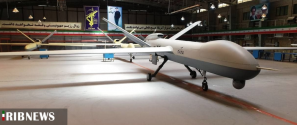
The Shahed-149 is the first Iranian turboprop UCAV, a major step forward for Iranian UCAV capability.
Performance/features:

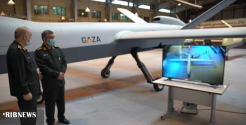

The IRGC has today revealed a large, turboprop MALE UCAV called Shahed-149 ("Gaza") to succeed the current generation Iranian Shahed-129 MALE UCAV (shown behind the larger S-149 in the photo below). The S-149 drone can be said to be in the American MQ-9 class of UCAVs.

The Shahed-149 is the first Iranian turboprop UCAV, a major step forward for Iranian UCAV capability.
Performance/features:
- Operational combat radius of 2000km
- First Iranian UCAV with turboprop engine
- Can carry up to 13 munitions
- New more powerful EO/IR sensors that enable 10km operational altitude
- 500km intelligence-gathering range
- 2-3x larger than previous generation Shahed-129 MALE UCAV (payload capacity unknown, but rumored 1000kg)



Last edited:
I posted this only two months ago (when the IRIAF revealed their own MALE UCAV: Kaman-22). The IRGC-ASF progresses even faster than I expected.Kaman-22 HALE UCAV (IRIAF)
The IRIAF unveiled its most advanced HALE UCAV drone today: Kaman-22. The most powerful Iranian UCAV by payload capacity.
The IRGC is currently testing its successor to the Shahed-129: Shahed-149. That is expected to be larger and more powerful than this [IRIAF Kaman-22], but is still a few years away. It is good to see the IRIAF develop larger and more powerful UCAVs - the IRIAF has typically lagged behind the IRGC-AF in terms of drone power (and still does in terms of high-end LO UCAVs/UAVs, but good to see their progress).

